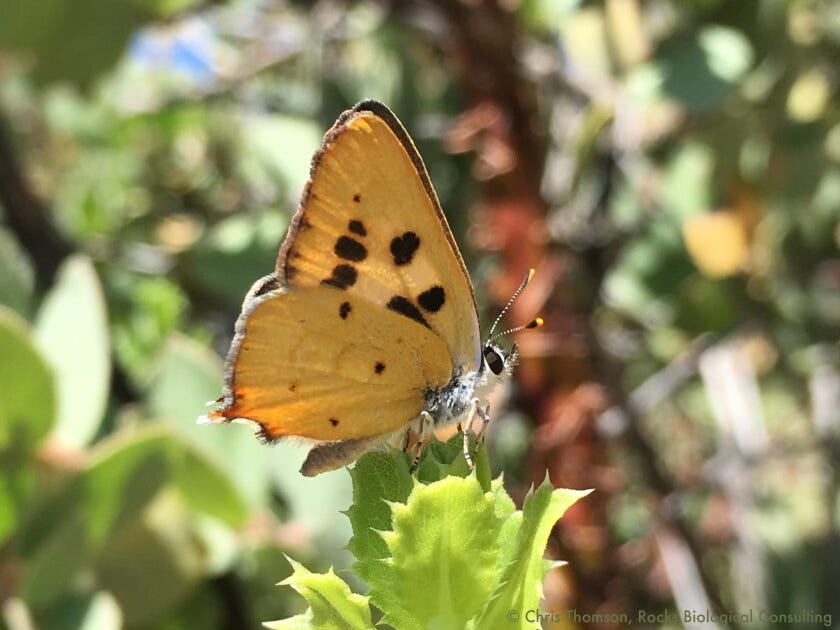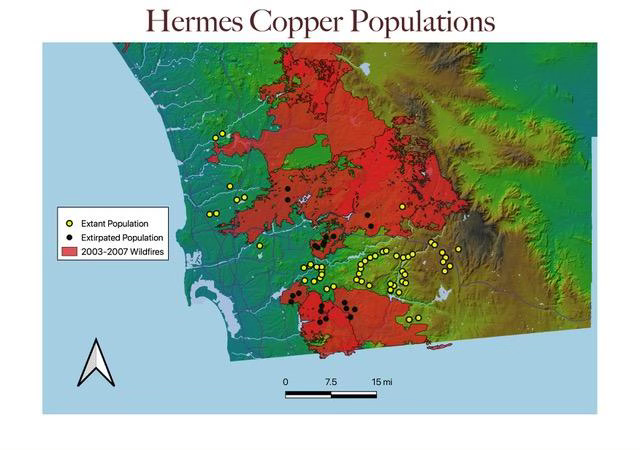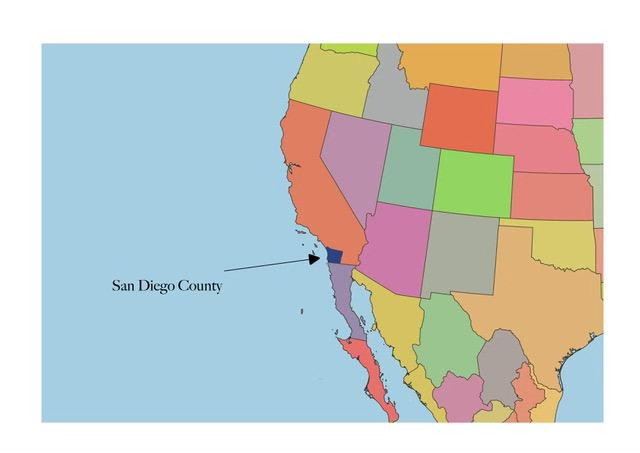In Touch: the endangered Hermes copper butterfly
More conservation efforts may be needed to save this rare butterfly
In my pollinator garden stand three spiny redberry plants. They are short, about two-and-a-half feet tall, evergreen, with small, ovate leaves, and otherwise fairly nondescript.
Spiny redberry plants are not usually suggested for native landscaping or pollinator gardens here in Southern California. I guess people don’t like them because they’re so nondescript. These shrubs just don’t distinguish themselves much from other plants. But I made sure to include them in my garden because they are the host plant for the endangered Hermes copper, a butterfly that only lives here in San Diego County and in the northernmost region of Baja California, Mexico.
Butterflies and moths feed on the nectar of flowers, but when they are caterpillars, they munch leaves and stems of plants. These plants are known as host plants. The Hermes copper chooses only one plant as its host, the spiny redberry.
I have no hope of attracting Hermes copper butterflies to my garden. Their habitats lie several miles east, and a big swath of development and freeways sprawl between here and there. I wanted to include the redberry in the garden to illustrate to our visitors that host plants for pollinators are just as important as the flowering plants the bees and butterflies visit. I also wanted to bring attention to this endangered butterfly.
The status of the Hermes copper
Historically, this small, yellow butterfly with brown spots was distributed more widely, but habitat loss—mostly because of urban development—has extirpated the butterfly from much of its historic range. Additionally, two years of catastrophic wildfires, in 2003 and 2007, destroyed several populations of the butterfly in portions of San Diego County (see map below). The populations that remain occupy about nine percent of San Diego County’s acreage. That’s not much. There may be a few populations of this butterfly on private property, but their numbers likely do not affect current assessments for the species.
Besides the number of populations declining, individuals within populations of the Hermes copper also have declining numbers. Past surveys counted 50 to hundreds of individual butterflies on a single day. Today, most populations number fewer than 50. Some populations number five or fewer.
These butterflies don’t fly far. Adults will range only about 60 feet from a home point. Not traveling far, individuals have little chance of reaching other populations. This lack of connectivity among populations can increase the chance of inbreeding and result in what biologists call genetic bottlenecking and can be a great threat to the health and survival of a species.
Climate change also may be endangering the Hermes copper. The butterfly’s numbers tend to increase during wet winters and decrease during dry ones, and we are getting more dry winters in Southern California due to climate change. Today’s remaining populations reside in higher elevations in San Diego County, where winter and spring rains are more reliable.
Although the butterflies can live in degraded habitat, invasive plant species threaten them because the introduced species push out the native plants on which the butterfly relies. Also, it seems that nonnative grasses growing under redberry shrubs inhibit the butterflies from laying their eggs.
Hashed out in the 1990s, municipalities in the county and the county government itself established what is called the Multiple Species Conservation Plan, an attempt to protect nearly 100,000 acres within the county boundary as refuge for native flora and fauna. Yet recent research indicates that this set-aside may not be enough. Almost all species of butterflies, including the Hermes copper, are declining across San Diego County. The ten most commonly observed butterflies declined by about one- and-a-half percent each year, and 20 less commonly seen species were found at almost six percent fewer transects each year.
Conservationists are considering translocation of butterfly individuals to reestablish populations, a promising proposition, as two populations of the Hermes copper naturally recolonized in the Cleveland National Forest east of San Diego after the 2003 and 2007 fires. Suitable habitat obviously needs to include spiny redberry for eggs and caterpillars, as well as the California buckwheat on which the adult butterflies feed. Luckily, this buckwheat is a fairly common shrub found throughout Southern California.
Here is a map showing the populations of Hermes Copper. I only have records for San Diego. I could not find any surveys of the insect in Baja. Note that the extirpated populations lie within the burn scars of the wildfires that burned the county in 2003 and 2007.
Below shows the reference of the above map. All map files are from SanGIS and Natural Earth. Maps were rendered in QGIS.
Sources:
San Diego County Hermes Copper (Lycaena hermes) Habitat Conservation and Management Plan Dr. Daniel Marschalek and Dr. Douglas Deutschman PI Department of Biology, San Diego State University April 24, 2017
Hermes Copper Butterfly Surveys and Translocation Efforts Daniel Marschalek, Ph.D School of Natural Sciences University of Central Missouri August 14, 2020








Although Hermes Copper in general don't travel far from home, the occasional individual will travel some distance from its home in search of new habitat (think the long tail of a bell curve). So planting redberry and flat-top buckwheat (the adult's favorite nectar source) in the vicinity of El Cajon and Alpine would be a proactive conservation measure.
Thank you for this Article. I grew up in San Diego and love insects, but had never heard of the Hermes Copper Butterfly.